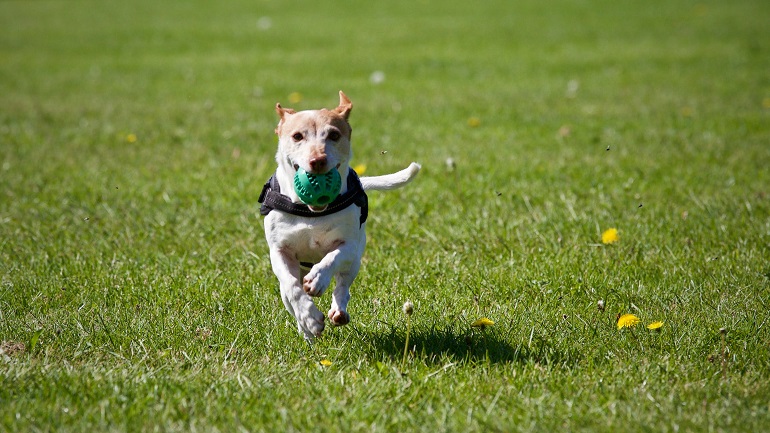My pup-nephew (my sister-in-law’s fur baby) doesn’t have a fenced-in yard. Dexter the Goldendoodle is a wanderer.
In fact, he has wandered right on into neighbors’ houses to see what they are up to. Luckily my SIL’s neighbors all love Dexter and find his antics quite charming.
However, my sister-in-law has been trying to come up with solutions for how to keep Dexter close without a fenced yard because it’s just not safe. Some of the neighborhood dogs aren’t super friendly, and a few streets over is a very busy road.
While a physical fence is definitely the ideal solution to contain your dog in the yard, that’s not always possible, either because of budget or housing regulations.
So how to keep the dog in the yard without a fence? Well, I’m so glad you asked!
Some Different Ways To Keep Your Dog in a Yard Without a Fence
Below are seven different methods for how you can keep your dog nice and safe in your yard without a fence.
You can find more info on non-permanent and semi-permanent dog fences in our blog!
Invisible Fence
One common option is to set up some sort of invisible fence. With old-school electric fences, you have to bury underground wire all along the perimeter of your property. That takes a lot of manual labor and may not be allowed in your area.
The good news is that there is a new style of invisible fence called GPS fences and they’re amazing!
My favorite of these invisible fences is the Halo 2. Here’s how it works:
Your dog wears the Halo collar and with the app on your phone, you can create invisible fences. Any time your dog approaches the boundary line that you’ve set, they will receive some sort of feedback from the collar: either sound, vibration, or mild static shock.
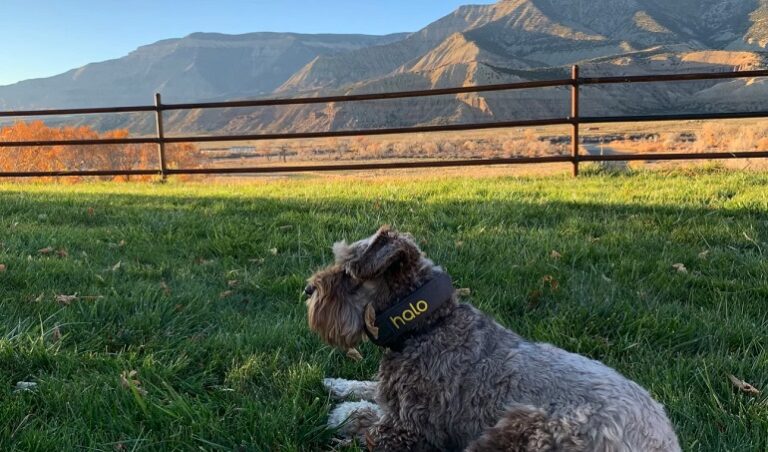
If your dog crosses the invisible fence boundary that you have set, you will be able to locate them in a heartbeat on the app because of the GPS in the collar (it’s like how your phone has a GPS).
With this option, you create up to 20 different invisible fences. You could have boundaries created for your house, your mom’s house, the dog park, or create one when you’re camping with your pup.
If you just want to be able to know where your dog is without them wearing any kind of shock collar, the Fi Smart Collar is a great option. It is also a health monitor to make sure your dog stays in top shape.
Tie-Outs
A tie-out is a quick and inexpensive way to keep your dog in your yard without a fence. You purchase a giant corkscrew-looking thing with a loop on the top and twist it into the ground. Then you attach the tie-out cord to the loop on the corkscrew, and you’re good to go.
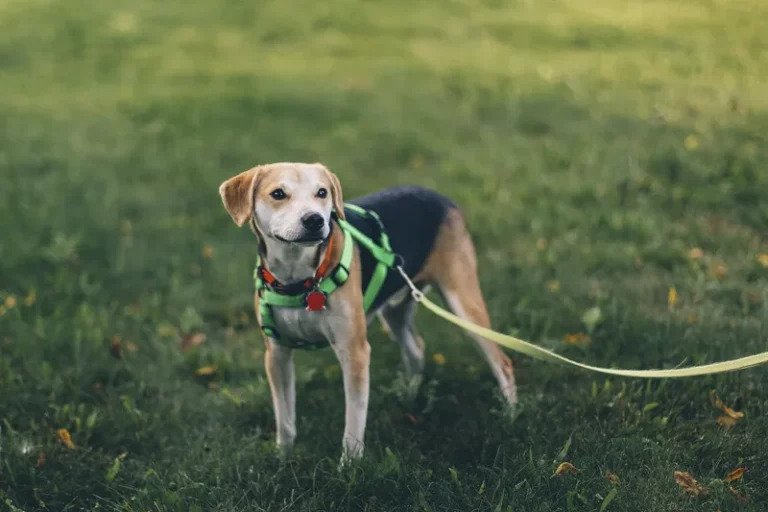
There are a few important things to remember with this method:
- Tie-outs come in different sizes and weights for different-sized dogs. If you get one too small for your big dog, they may be able to pull it out of the ground. If you get one too big for your small dog, the hardware and cord may be too heavy for them to move freely.
- You’ll want to be careful where you place tie-outs because the cord can easily get tangled or wrapped around anything on the ground. If you leave your dog alone on a tie-out, they could get tangled up and be unable to reach their water dish or get injured.
We have used tie-outs for our dogs before when we’re visiting a family member’s house that doesn’t have a fenced-in yard. It is an easy non-permanent solution that gives our pups a bit more freedom and me a bit more peace of mind.
Long-Line
A long line is basically a super long leash. These can be 15 to 50 feet long! So basically, the idea with using a long line if you can’t have a fence is that you are able to go outside with your dog and keep them “contained” but with extra freedom to roam.
Long lines are often used during dog training classes. We had to buy one for our dog Rudy’s puppy school so that we could teach him to “come” without risking that he would not come and would wander off.
The benefits of long lines are that they are simple, cheap, and you can start using one immediately.
The downside is that you have to be outside with your dog, so this solution doesn’t allow your dog to be outside without you.
Also, because it is so long, a long line can easily get wrapped around trees or caught on things on the ground. You might spend more time than you’d like untangling this ultra-long leash.
Trolley Lines
Many owners install a trolly line when they can’t fence in their whole yard. This is a line that you string between two structures (like your house and a tree). Then you attach a leash to a pulley so that your dog can be out in the great outdoors without constant supervision.
One mistake to avoid is hanging the trolly line too low. It may droop a bit over time, and you want all humans in the house to be able to safely walk under it.
Trolly lines give can give your dog a nice large area to roam. Since the leash is quite short and goes up above them, there are fewer issues with it getting tangled.
Outdoor Kennel
An outdoor kennel can allow your dog to be outdoors without any possibility that they will leave the yard. These are small areas with a tall chain link fence that is not actually stuck to the ground. Some outdoor kennels also have a chain link “roof” as well.
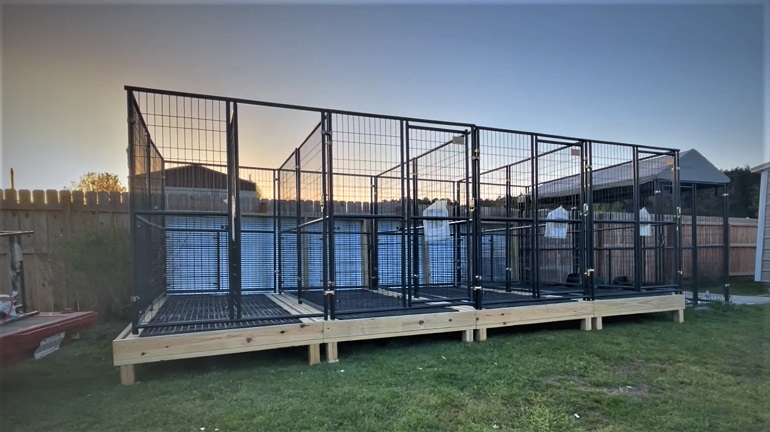
Usually, outdoor kennels are fairly small. You might have enough space for a dog bed, a water dish, and room for your pup to go to the bathroom.
Your dog won’t have enough room to get much exercise, and you shouldn’t plan on leaving your dog in it for extended periods of time. However, it does at least give your dog a safe place to get some fresh air. Outdoor kennels can work to keep a very large dog contained.
Exercise Pen
Small dogs can enjoy getting more exercise in an outdoor exercise pen. This is a freestanding fence, usually no more than a few feet tall. Since it is shorter, large dogs and jumpers won’t be contained in this.
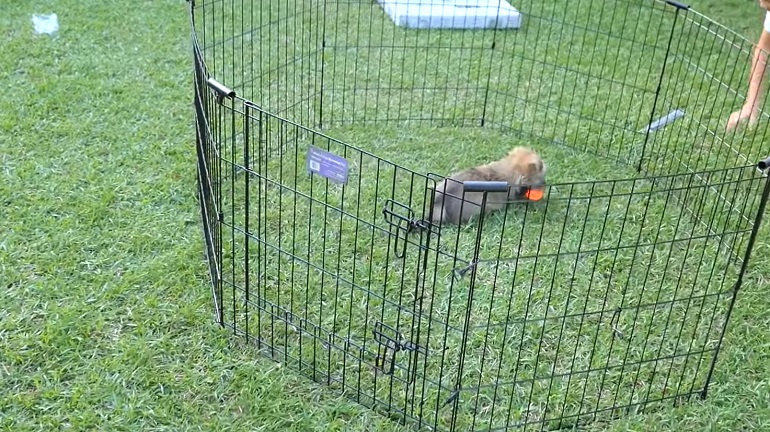
Exercise pens come in multiple small panels. They can often be assembled in different shapes and are portable. If you buy multiple sets of the same pen, you can usually connect them all together for a larger space.
Many users will set up exercise pens at their campsites so that their dogs can be off-leash.
Boundary Training
One option is to simply train your dog not to leave the yard through boundary training. This is by far the most time-consuming option and depending on the dog, might not be reliable.
However, if you can successfully train your dog to stay in the yard, you’ll likely have the added benefit of an all-around really well-trained pooch!
Pet owners can boundary train their dogs by first creating some sort of visual cue as to where the boundary line is. This could be by sticking little flags in the ground like you do for an electric fence or by laying a hose on the ground to create the line.
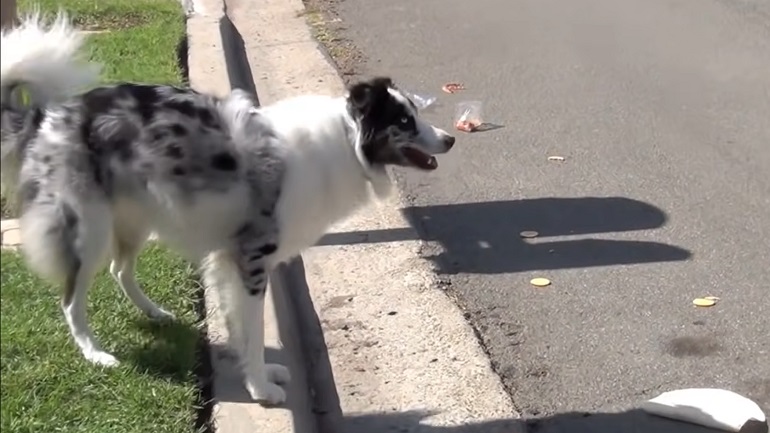
With your dog on a leash, walk them around the inside of the yard. Anytime they go close to the line, call them back into the yard and throw treats for them.
Always praise your dog for staying within the boundary. If they move to cross the line, give the leash a tug and bring them back toward the middle of the yard.
Once your dog seems to understand where the line is, you can introduce some distractions. They should still be hooked up for this step. You can roll a ball across the boundary line. If they don’t try to go after it, give them lots of praise and treats.
After several weeks of working with your dog to understand where the boundary line is and making sure that they don’t cross the line, you can take them off leash and monitor them for a while before leaving them unsupervised.
You can contact a local dog trainer if you want help with boundary training your dogs.
A Few Reasons Why You Need To Keep Your Dog in the Yard
To Prevent Getting Hit by Cars
One of most dog owners’ worst nightmares is their beloved pup getting hit by a car. If you don’t have a way to keep your dogs inside the yard, this is a real possibility.

My husband’s dog growing up, was hit by a car, and it was devastating for the family. Putting effort into keeping your dog safe is always worth it.
To Prevent Your Dog From Biting Kids and Other People
Even many dogs who are extremely friendly can occasionally act out of character. Some kids and even adults don’t know how to properly interact with dogs and could push a pup to the point where they bite.
A puppy biting people is a serious issue. Animal control could be called in, and legal issues could arise if your dog has hurt someone.
I try to never let my dogs be put in a position where this is even a remote possibility. This is why some sort of long-term solution is necessary for keeping your dogs on your property.
It Can Be Illegal for Dogs To Roam
Depending on where you live, it could be illegal for your dog to roam freely. Letting them do so could get your dog confiscated or may cause you to pay a fine.
Be sure to check with your local regulations to see if it is ok if your dog wanders around the neighborhood. Even if it is legal though, it still isn’t safe for your dog or neighbors.
Issues With Other Dogs
Dog fights happen, and they can have horrible consequences.
My cockapoo is only 11 pounds but doesn’t back down if other dogs start to bother him. Because of this, I am very careful about which dogs he is allowed to play with as I don’t want him to get into a fight.
If your dog is not contained in your yard by a permanent fence, they could get out and get into a fight with other dogs. This can lead to serious injury or even death.
Your Dog Could Be Stolen
Dognapping happens (this means a dog being stolen). Unfortunately, if you don’t keep your dog safe on your property, they could get taken by some unsavory people.
Keeping your dog in the backyard makes this less likely. Using one of the non-fence solutions from this article will help as well.
Your Dog Could Eat Something Bad
If your dog roams the neighborhood, they could eat something that they shouldn’t (especially on trash day).

Our dog Rudy had to have his stomach pumped once because he ate something dangerous. It was both expensive and super sad to see him not feeling well.
Dogs don’t always know if something is safe for them to eat or not. You can keep your pup safe by keeping them close to home.
Should I Leave My Dog Alone in My Unfenced Yard?
There are always some risks involved in leaving your dog alone in an unfenced yard. One risk is that while your dog may not be able to leave, other animals are able to get to your dog and might start a fight or hurt him.
It’s also possible that a sketchy person could dognap your furry friend, which would be devastating. This is not uncommon.
Dogs are pack animals. They are social. They want to be with their family. Leaving your dog alone outside for long periods of time can cause loneliness, boredom, or anxiety. If your dog is feeling those emotions, it is more likely that they will engage in unwanted behaviors.
Use your common sense and pay attention to how your dog is doing. You might be able to leave your pup alone for short periods of time while you are home and can check on them regularly.
However, it is unwise to leave them alone outside for long periods of time if you are not home.
Safety Note: If your dogs are outside without a fence, be sure that they are always wearing a dog collar with up-to-date ID tags.
Some Final Thoughts
There are actually many ways to keep your dog close to home, even if you cannot build a fence.
Each option definitely has its pros and cons in terms of permanence, training required, and how much they cost. Depending on your dog’s size, some options will work better than others.
The best solution for you will be unique to your property, pup, budget, and needs.


